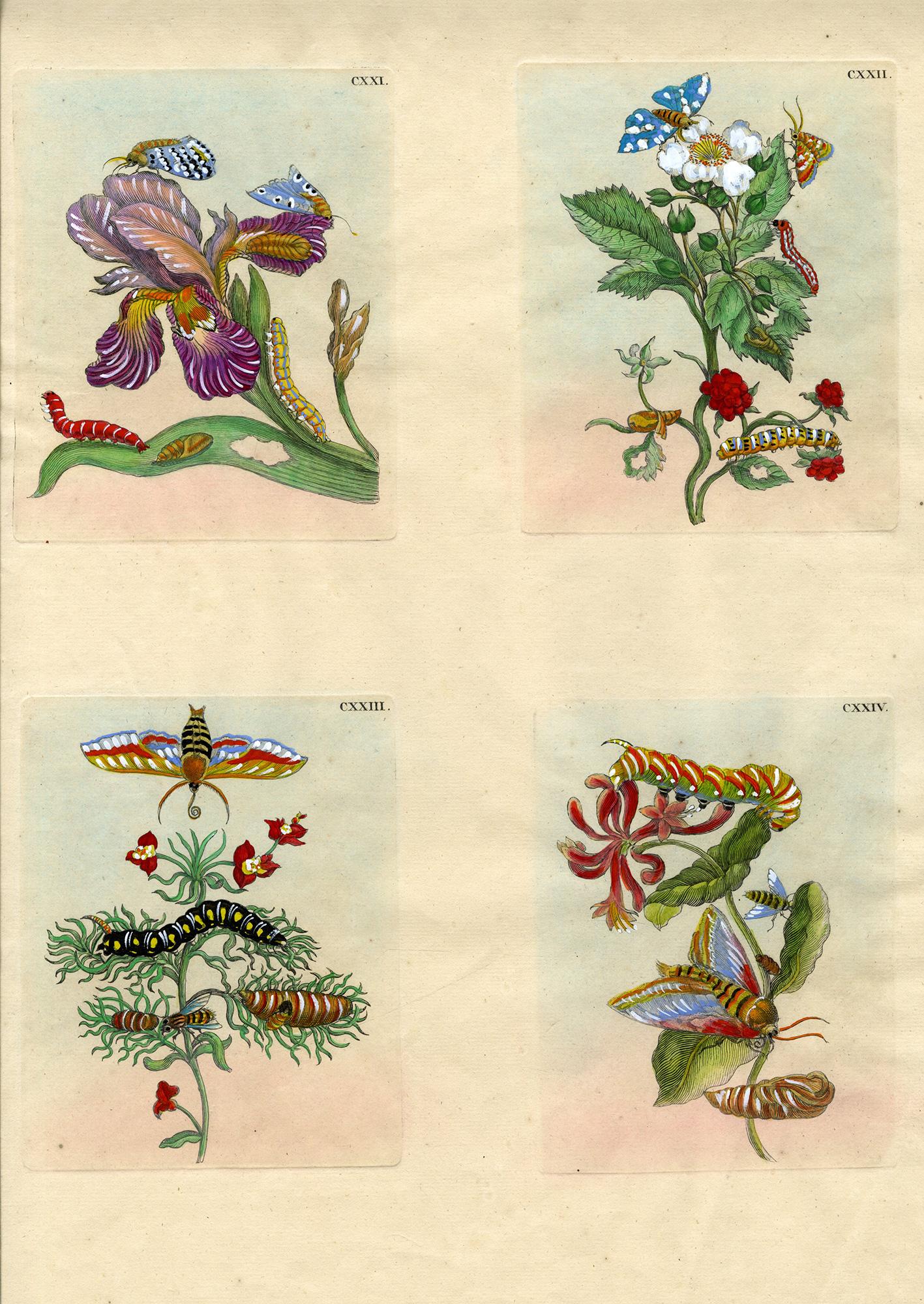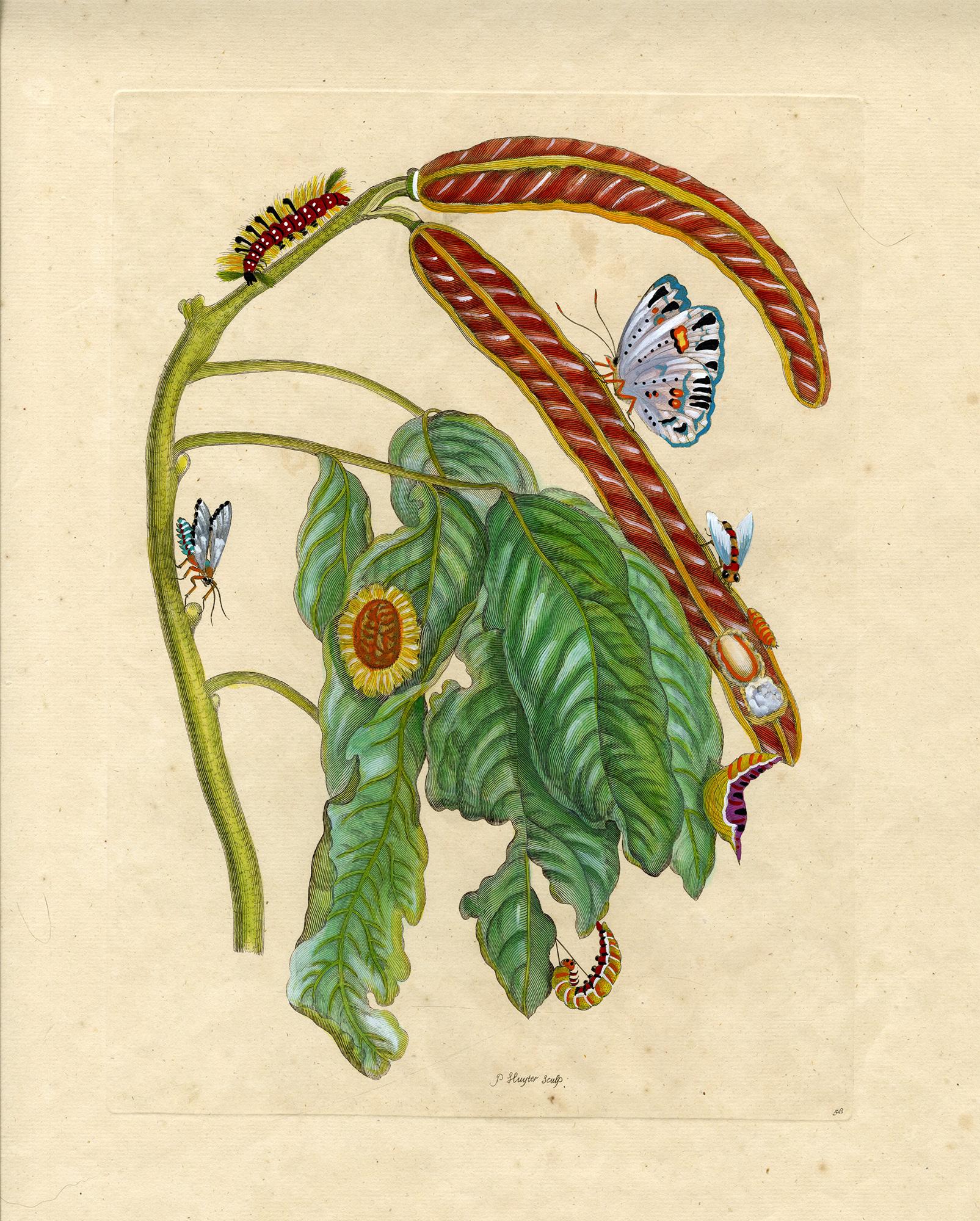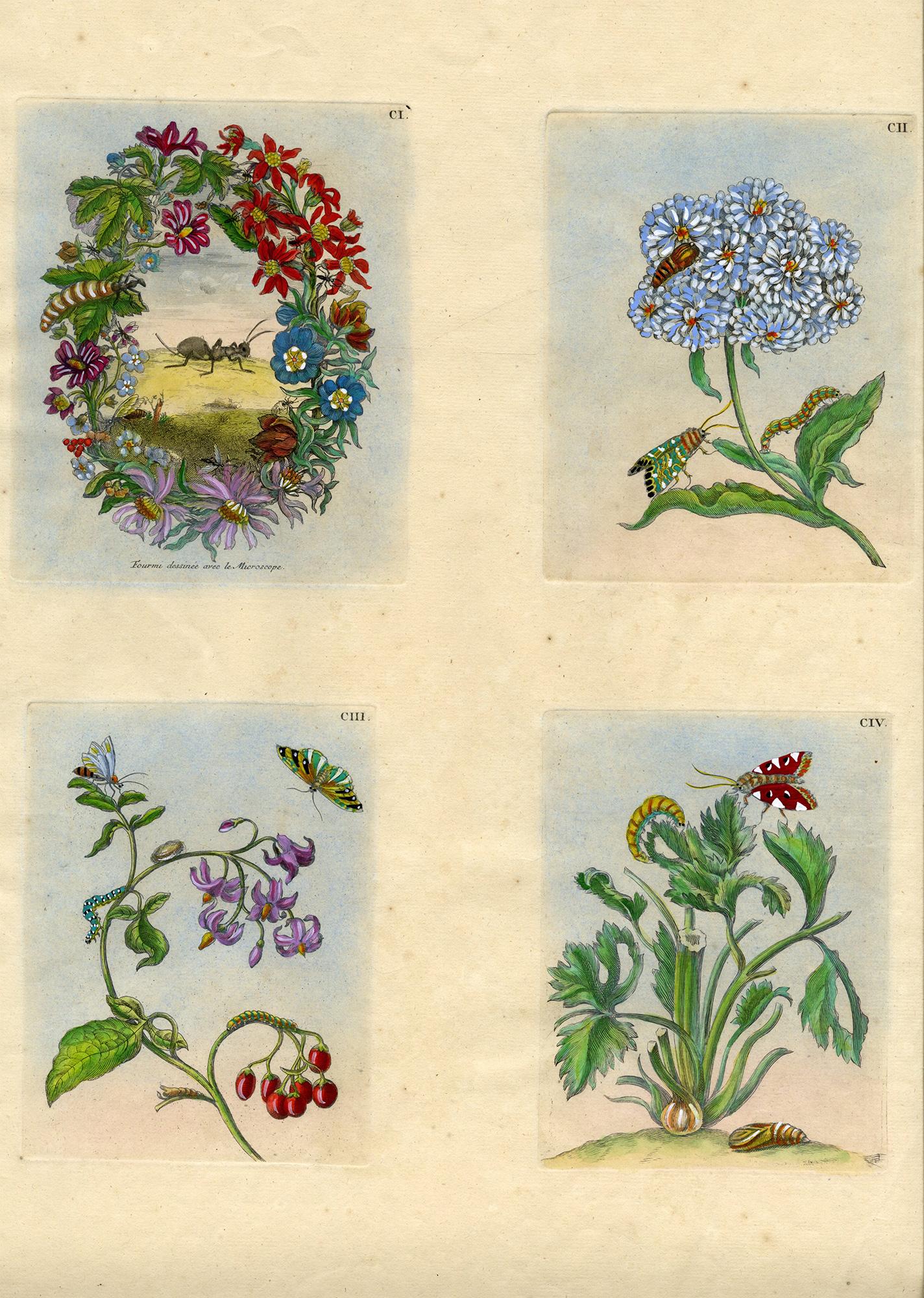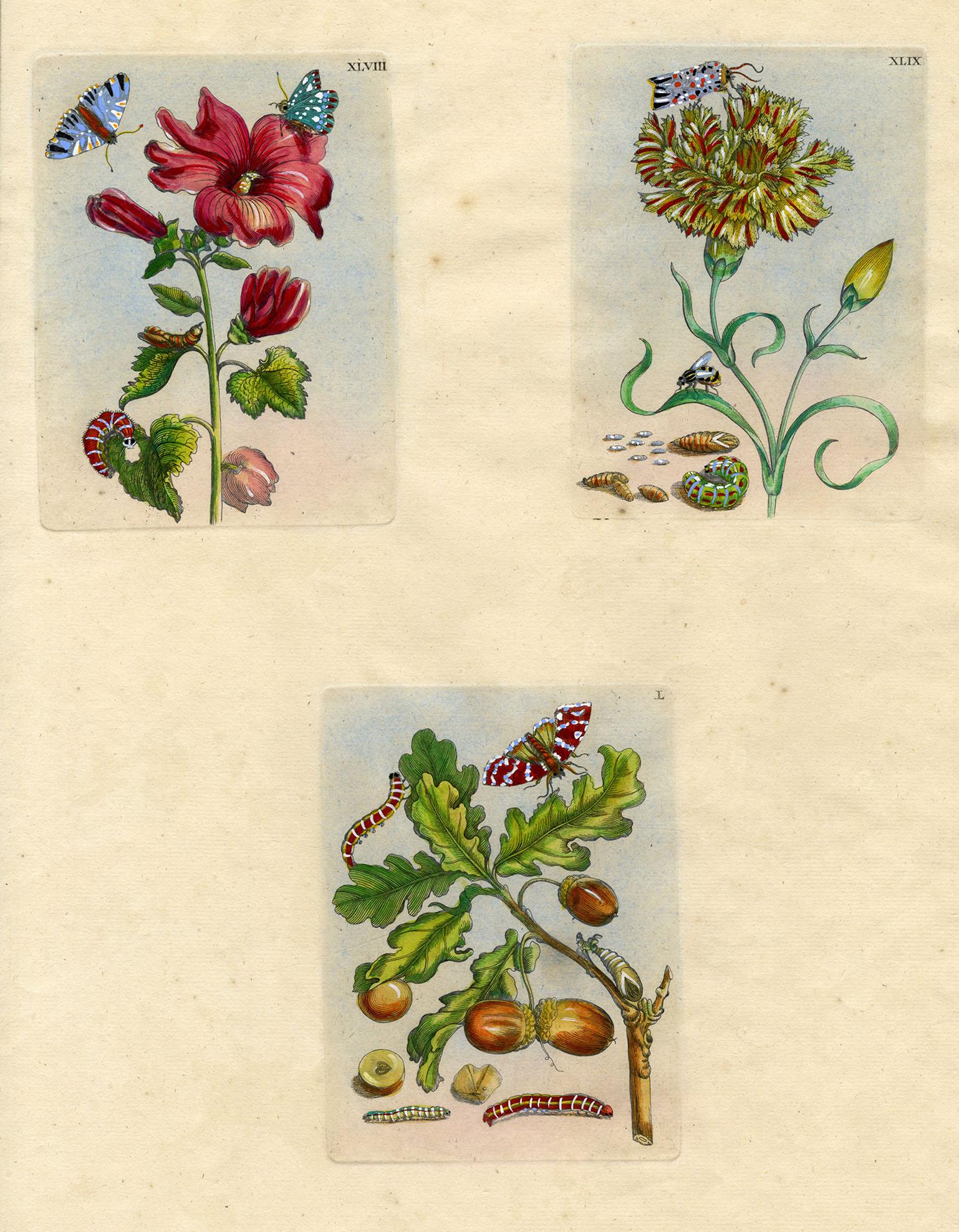Items Similar to Cocoa plant, caterpillar, ..., Plate 26, Metamorphosis Insectorum Surinamensium
Want more images or videos?
Request additional images or videos from the seller
1 of 2
Maria Sibylla MerianCocoa plant, caterpillar, ..., Plate 26, Metamorphosis Insectorum Surinamensium1705
1705
About the Item
Metamorphosis Insectorum Surinamensium, Plate No. 26; Cocoa plant, caterpillar, pupa, and butterflies. The Netherlands: 1705. Engraving with hand coloring in watercolor on watermarked Honig cream laid paper. 12 7/8 x 9 5/8 inches (327 x 245 mm), sheet 20 5/8 x 14 inches (522 x 354), full margins. Minor handling wear, and scattered light spots of minor discoloration throughout. Colors remain extremely vibrant. From the edition engraved by Pieter Sluyter, printed early between 1719 and 1730.
Translation of the original text regarding Plate No. 26: "This plate shows a branch of a Cacau boom [cocoa tree], of which the leaves are hard, stiff and grass-green. The trees grow as tall as an apple tree and bear simultaneously blossom, ripe and unripe fruits. The blossom is reddish and sprouts from either side of the wood. The young fruits are reddish-green. When they are ripe they are yellow like lemons. They have thick peels, which are used as fertilizer and as manure for the land.
The beans or seeds are dried and hardened in the shade before, they are sent to other countries. These trees grow very well in Suriname although they are difficult to cultivate, because they must always shelter under another tree, which protects them from the heat of the sun, since they cannot stand the great heat. That is why they are planted next to a banana or Bakoven when they are still young, in order to shield them from the heat.
On these cocoa trees I found large numbers of black caterpillars with red stripes, like the one shown on the green leaves, feeding on the foliage. They have red stripes with white spots. They are very slow and sluggish by nature. On 26 March I saw them turn into pupae, from which white moths emerged on 10 April, adorned with black stripes and spots."
NOTES ON THE WATERMARK:
"Watermarks representing the arms of Strasbourg, a bend on a •shield surmounted by a large fleur-de-lys, are characteristic of 'Royal Paper'; paper of the largest standard size and always of high quality. In various forms, the 'Strasbourg Lily' occurs in Angoumois, Dutch and English papers in the later seventeenth and eighteenth centuries. The `WR' monogram at the bottom of the mark probably originated as the personal sign of Wendelin Riehel, a printer who rented a paper mill in Strasbourg during the sixteenth century; it was later widely used as a neat but meaningless termination to the pendant centre-line of many heraldic watermarks." [Viola a da Gamba Society, Appendix I: Watermarks and Paper Types, 268-272]
The design of the Strasbourg Lily was used by the Honig papermakers between 1741 and 1822. The lettering "C & I HONIG" occurs between 1730 and 1869. It is known that the brothers Cornelis Jacobszoon and Jan Jacobszoon Honig worked together under the name "C & I Honig" but started new companies, each one for himself, in 1738. Cornelis (1683-1755) continued under the name "C & I Honig," now together with his son Jacob Cornelisz Honig (1707-1770). [Klepikov, S. A., Some information over the "Honig" watermarks, IPH Information. Bulletin of the International Association of Paper Historians (IPH), N.S., vol. 6, no. 1 (January 1972), 10-13.]
MARIA SIBYLLA MERIAN was one of the most highly respected entomologists of the 17th century, and remains today one of the field's most significant figures. A German-born naturalist and scientific illustrator, she reared herself on the study of caterpillars, and made tremendous contributions to the knowledge of the life cycles of numerous species. Until her detailed and careful study of the process of metamorphosis it was commonly believed that insects were "born of mud," through spontaneous generation. Trained as a miniature painter by her stepfather, she published her first book of illustrations in 1675, at the age of 28. In 1679, Merian published the first volume of the two-volume series on caterpillars, The Wondrous Transformation of Caterpillars and their Strange Diet of Flowers; the second volume followed in 1683. Each volume contained 50 plates that she engraved and etched.
In 1699, Merian traveled to Dutch Guiana with her daughter to study and record the tropical insects native to South America. The result was her 1705 magnum opus, Metamorphosis Insectorum Surinamensium. Merian's Metamorphosis has been credited with heavily influencing the way naturalists presented their illustrations to include a life form in various stages of development.
Years after her death, Merian has been honored by having a number of taxa and three genera named after her. According to Jennifer Pomeroy's 2018 biography, three butterflies have been named after Merian; in 1905 a form of a split-banded owlet butterfly Opsiphanes cassina merianae; in 1967 a subspecies of the common postman butterfly Heliconius melpomene meriana; and in 2018 a rare butterfly Catasticta sibyllae from Panamá. In addition, the Cuban sphinx moth has been named Erinnyis merianae, a Tessaratomidae bug has been named Plisthenes merianae, a genus of mantises has been named Sibylla, the orchid bee Eulaema meriana, and the bird-eating spider Avicularia merianae was named in her honor, referencing her research on spiders. The spider Metellina merianae was named after her in 2017. An Argentine tegu lizard has been named Salvator merianae. A toad was named Rhinella merianae. A snail was named Coquandiella meriana. The Madagascan population of the African stonechat bird was given the name Saxicola torquatus sibilla. A genus of flowering plants was named Meriania, and an iris-like plant was given the name Watsonia meriana. [Sarah B. Pomeroy; Jeyaraney Kathirithamby (2018). Maria Sibylla Merian: Artist, Scientist, Adventurer. Getty Publications.]
- Creator:Maria Sibylla Merian (1647 - 1717, Dutch)
- Creation Year:1705
- Dimensions:Height: 12.88 in (32.72 cm)Width: 9.63 in (24.47 cm)
- Medium:
- Movement & Style:
- Period:
- Condition:
- Gallery Location:Middletown, NY
- Reference Number:
About the Seller
5.0
Vetted Seller
These experienced sellers undergo a comprehensive evaluation by our team of in-house experts.
Established in 2004
1stDibs seller since 2022
29 sales on 1stDibs
Typical response time: 12 hours
- ShippingRetrieving quote...Ships From: Middletown, NY
- Return PolicyA return for this item may be initiated within 30 days of delivery.
More From This SellerView All
- 4 plates from The Wondrous Transformation of Caterpillars & their Strange Diet..By Maria Sibylla MerianLocated in Middletown, NYFour plates from The Wondrous Transformation of Caterpillars and their Strange Diet of Flowers. “Wolfsmelk Rupsen;" “Wolfsmilch, Raupe und Schmetterling" Amsterdam: J F Bernard, 1730. Each an engraving with hand coloring in watercolor and gouache printed on one sheet of watermarked Honig cream laid paper, each measures 6 1/4 x 5 inches (157 x 121 mm), sheet measures 20 5/8 x 14 inches (522 x 355 mm), full margins. With one 1.5 inch inch tear across the area of the top-left corner, well outside of image area. Handling creases in the lower right sheet quadrant, as well as minor, loose cockling, otherwise in very good condition. The colors are superb with exceptionally fresh and bright saturation. Engraved between 1679 and 1683, printed 1730. Plates included: CXXI, CXXII, CXXIII, & CXXIV. MARIA SIBYLLA MERIAN was one of the most highly respected entomologists of the 17th century, and remains today one of the field's most significant figures. A German-born naturalist and scientific illustrator, she reared herself on the study of caterpillars, and made tremendous contributions to the knowledge of the life cycles of numerous species. Until her detailed and careful study of the process of metamorphosis it was thought that insects were "born of mud," through spontaneous generation. Trained as a miniature painter by her stepfather, she published her first book of illustrations in 1675, at the age of 28. In 1679, Merian published the first volume of the two-volume series on caterpillars, The Wondrous Transformation of Caterpillars and their Strange Diet of Flowers; the second volume followed in 1683. Each volume contained 50 plates that she engraved and etched. In 1699, Merian traveled to Dutch Guiana...Category
Early 18th Century Naturalistic Still-life Prints
MaterialsWatercolor, Engraving
- Icecream Bean plant..., plate no. 58, Metamorphosis Insectorum SurinamensiumBy Maria Sibylla MerianLocated in Middletown, NYMetamorphosis Insectorum Surinamensium, Plate No. 58; Ice Cream Bean Plant, Cloudless Sulphur Butterfly and Caterpillar with Mot...Category
Early 18th Century Naturalistic Still-life Prints
MaterialsWatercolor, Engraving
- 4 plates from The Wondrous Transformation of Caterpillars & their Strange Diet..By Maria Sibylla MerianLocated in Middletown, NYFour plates from The Wondrous Transformation of Caterpillars and their Strange Diet of Flowers. “Wolfsmelk Rupsen;" “Wolfsmilch, Raupe und Schmetterling" Amsterdam: J F Bernard, 1730. Each an engraving with hand coloring in watercolor and gouache printed on one sheet of watermarked Honig cream laid paper, each measures 6 1/4 x 5 inches (157 x 121 mm), sheet measures 20 5/8 x 14 inches (522 x 355 mm), full margins. With handling creases in the lower right sheet quadrant, as well as minor, loose cockling, otherwise in very good condition. The colors are superb with exceptionally fresh and bright saturation. Engraved between 1679 and 1683, printed 1730. Plates included: CI; CII; CIII & CIV. MARIA SIBYLLA MERIAN was one of the most highly respected entomologists of the 17th century, and remains today one of the field's most significant figures. A German-born naturalist and scientific illustrator, she reared herself on the study of caterpillars, and made tremendous contributions to the knowledge of the life cycles of numerous species. Until her detailed and careful study of the process of metamorphosis it was thought that insects were "born of mud," through spontaneous generation. Trained as a miniature painter by her stepfather, she published her first book of illustrations in 1675, at the age of 28. In 1679, Merian published the first volume of the two-volume series on caterpillars, The Wondrous Transformation of Caterpillars and their Strange Diet of Flowers; the second volume followed in 1683. Each volume contained 50 plates that she engraved and etched. In 1699, Merian traveled to Dutch Guiana...Category
Early 18th Century Naturalistic Still-life Prints
MaterialsWatercolor, Engraving
- 4 plates from The Wondrous Transformation of Caterpillars & their Strange Diet..By Maria Sibylla MerianLocated in Middletown, NYFour plates from The Wondrous Transformation of Caterpillars and their Strange Diet of Flowers. “Wolfsmelk Rupsen;" “Wolfsmilch, Raupe und Schmetterling" Amsterdam: JF Bernard, 1730. Each an engraving with hand coloring in watercolor and gouache printed on one sheet of watermarked Honig cream laid paper, each measures 6 1/4 x 5 inches (157 x 121 mm), sheet measures 20 5/8 x 14 inches (522 x 355 mm), full margins. With handling creases in the lower right sheet quadrant, as well as minor, loose cockling, otherwise in very good condition. The colors are superb with exceptionally fresh and bright saturation. Engraved between 1679 and 1683, printed 1730. Plates included: CXLI, CXLII, CXIII & CXLIV. MARIA SIBYLLA MERIAN was one of the most highly respected entomologists of the 17th century, and remains today one of the field's most significant figures. A German-born naturalist and scientific illustrator, she reared herself on the study of caterpillars, and made tremendous contributions to the knowledge of the life cycles of numerous species. Until her detailed and careful study of the process of metamorphosis it was thought that insects were "born of mud," through spontaneous generation. Trained as a miniature painter by her stepfather, she published her first book of illustrations in 1675, at the age of 28. In 1679, Merian published the first volume of the two-volume series on caterpillars, The Wondrous Transformation of Caterpillars and their Strange Diet of Flowers; the second volume followed in 1683. Each volume contained 50 plates that she engraved and etched. In 1699, Merian traveled to Dutch Guiana...Category
Early 18th Century Naturalistic Still-life Prints
MaterialsWatercolor, Engraving
- 3 plates from The Wondrous Transformation of Caterpillars & their Strange Diet..By Maria Sibylla MerianLocated in Middletown, NYThree plates from The Wondrous Transformation of Caterpillars and their Strange Diet of Flowers. “Wolfsmelk Rupsen;" “Wolfsmilch, Raupe und Schmetterling" Amsterdam: J F Bernard, 1730. Each an engraving with hand coloring in watercolor and gouache printed on one sheet of watermarked Honig cream laid paper, each measures 6 1/4 x 5 inches (157 x 121 mm), sheet measures 20 5/8 x 14 inches (522 x 355 mm), full margins. With handling creases in the lower right sheet quadrant, as well as minor, loose cockling, otherwise in very good condition. The colors are superb with exceptionally fresh and bright saturation. Engraved between 1679 and 1683, printed 1730. Plates included: XLVIII; XLIX & L. MARIA SIBYLLA MERIAN was one of the most highly respected entomologists of the 17th century, and remains today one of the field's most significant figures. A German-born naturalist and scientific illustrator, she reared herself on the study of caterpillars, and made tremendous contributions to the knowledge of the life cycles of numerous species. Until her detailed and careful study of the process of metamorphosis it was thought that insects were "born of mud," through spontaneous generation. Trained as a miniature painter by her stepfather, she published her first book of illustrations in 1675, at the age of 28. In 1679, Merian published the first volume of the two-volume series on caterpillars, The Wondrous Transformation of Caterpillars and their Strange Diet of Flowers; the second volume followed in 1683. Each volume contained 50 plates that she engraved and etched. In 1699, Merian traveled to Dutch Guiana...Category
Early 18th Century Naturalistic Still-life Prints
MaterialsWatercolor, Engraving
- Tree with moth, caterpillar..., Plate 39, Metamorphosis Insectorum SurinamensiumBy Maria Sibylla MerianLocated in Middletown, NYMetamorphosis Insectorum Surinamensium, Plate No. 39; Unidentified tree with moth, caterpillar and pupa. The Netherlands: 1705....Category
Early 18th Century Naturalistic Still-life Prints
MaterialsWatercolor, Engraving
You May Also Like
- Green Painted Sea Shell Lithograph Edition 33 of 34By Frances NailLocated in Houston, TXGreen shell lithograph of a cone shell. Print is edition 33 of 34. Signed and dated by the artist along with titled. Print is framed in a golden frame...Category
1970s Naturalistic Still-life Prints
MaterialsLithograph
- Kate Boxer, I Won't Eat You, Limited edition animal print, contemporary artLocated in Deddington, GBI Won’t Eat You [2021] limited_edition Drypoint print Edition number of 30 Image size: H:81 cm x W:113 cm Complete Size of Unframed Work: H:92 cm x W:122 cm x D:0.1cm Sold Unframed ...Category
21st Century and Contemporary Contemporary Animal Prints
MaterialsDrypoint, Etching, Paper
- "The Winner" - Etching on Paper (10/25)Located in Soquel, CA"The Winner" - Etching on Paper Clean and modern drypoint etching of a horse skeleton by Maria Bennett (American, 20th Century). This etching has layer...Category
1970s Modern Still-life Prints
MaterialsPaper, Ink, Drypoint
- Colombe (Dove of Peace returns to ark with olive branch in her beak)By Mario AvatiLocated in New Orleans, LA"And the dove came in to him in the evening; and, lo, in her mouth was a plucked off olive leaf: so Noah knew that the waters were abated from off the earth." Mario Avati, a master ...Category
Late 20th Century Contemporary Animal Prints
MaterialsMezzotint
- Snail in a Bowl (Artist Proof inscribed to Fritz Eichenberg)Located in New Orleans, LALeonard Merchant's mezzotint, "Snail in Cup" is inscribed for fellow artist, Fritz Eichenberg. While a student at the Central School for Arts and Crafts in London, a young Leonard Marchant found an engraving rocker in a cupboard and proceeded to turn himself into a master of the painstaking art of mezzotinting. Marchant, who has died in Shrewsbury aged 70, grew up in Simonstown, the Royal Navy's enclave in South Africa. Though his first job was as a parliamentary messenger, he taught himself to paint and, aged 19, was given a one-man show in Cape Town. Fired by this success, he left for England to study painting and, he claimed, to escape the stifling home atmosphere created by his Catholic mother and aunts. (His father was killed in the second world war.) Without contacts in London, he phoned Jacob Epstein, whose recommendation resulted in a grant to study briefly at the Central School. It was later, when studying full-time at the Central, that he saw the mezzotints of the Japanese master, Yozo Hamaguchi, in a London gallery. He was hooked. Creating a mezzotint is tedious in the extreme. The copper plate must first be prepared with a "rocker" which roughens the surface. A plate may be "rocked" 30 or 40 times. The rough texture is then reduced with a burnisher and a scraper, allowing the print a range of tones from velvety black through the greys to white. Marchant's plates could be months in the making. But the technical demands were the least of his worries. In its 18th- and 19th-century heyday, mezzotint was solely a reproductive medium, for copying masters such as Reynolds and Turner. The development of photography rendered it unfashionable, and by the 1960s the technique, known as la manière anglaise, was a bygone medium. Marchant, by now a teacher in printmaking at the Central, began to create original mezzotints with a colleague, Radavan Kraguly. A perfectionist, he seemed to revel in the straitjacket procedure. Perhaps it was the metaphor of bringing darkness out of light that appealed to this straight-talking, sometimes sombre, man, who would suddenly relax and light up like a gleaming hue on one of his prints. His work was of squares and triangles with the occasional cat, black and ominous, and carefully arranged still lifes, featuring plants, a seed pod, a pot he might have bought at auction to celebrate the sale of a print. There were one-man shows, notably at the Bankside Gallery. He sold well at the Royal Academy summer exhibition, was a Florence Biennale prizewinner, spent a fellowship year at the British School in Rome, and was elected a Fellow of the Royal Society of Painter-Printmakers. But making mezzotints was not a paying job. Marchant and his South African wife...Category
1980s Modern Animal Prints
MaterialsMezzotint
- Python Sebae (African Rock Python Skull)By Jacob CrookLocated in New Orleans, LAPython is a hand-pulled mezzotint in an edition of 25. This is #7/25. Jacob Crook was born in St. Louis, MO in 1985. Crook works primarily in the intagli...Category
2010s American Modern Animal Prints
MaterialsMezzotint





